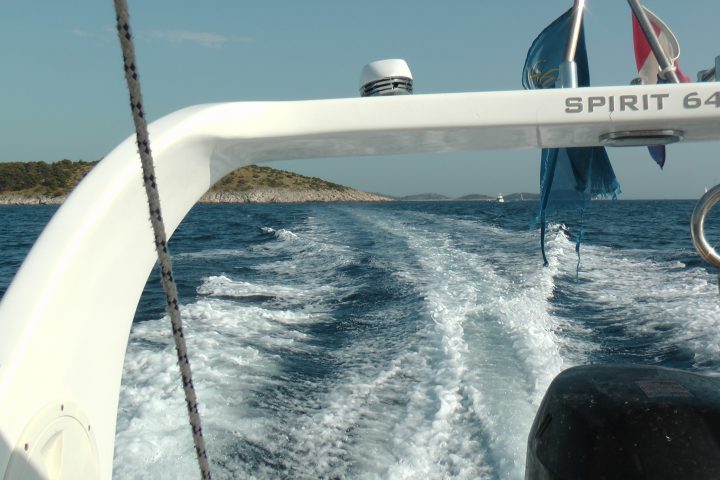What you should know when chartering a boat
First-time bareboat charterers should bear in mind some essential points.
 Charterboat (RIB) in Croatia.
Charterboat (RIB) in Croatia. The information below will help you conclude correct charter contracts. The exact country-specific requirements and applicable legislation can be found on the country info pages compiled by the ADAC nautical tourism team.
Popular cruising grounds for seagoing motor and sailing yachts include Croatia, the Balearic Islands, Sardinia, Corsica, the Côte d’Azur and the Baltic Sea. The Canary Islands, the Caribbean and Asia are popular winter cruising grounds.
What you should keep in mind before signing the contract
- Do you have the required boat licences and seamanship credentials (e.g. skipper qualification for inland/coastal waters, or radio licence)? Such requirements should be clarified since insurance cover could be denied.
- What is the inventory of the boat?
- Are the boat type and size adequate for your purposes (cabins, WC, shower, pantry)?
- What is the deposit amount and how is the deposit to be made (cash, cheque, credit card)?
- What are the services included in the charter price? Are there any additional costs, e.g. for linens, cleaning or dinghy and outboard motor?
- Are pets allowed?
- Is there a parking facility for your vehicle? If so, is it enclosed or open, is it included or at extra charge?
- Are there any bicycles on board?
- Does the charter contract specify (i.e. limit) the cruising area?
- What is the extent of coverage provided under the charter contract? Does the contract provide for personal liability or a non-waivable responsibility (deductible) for the charterer in the case of damage or loss?
- Are you covered against travel or charter cancellation fees? Charter deposit insurance covers the guarantee amount withheld in the case of damage to the charter yacht. A skipper’s third party liability insurance provides additional cover. It kicks in if the liability insurance covering the charter yacht has security loopholes or is voided due to gross negligence, for instance.
Important points in the charter contract
The charter contract is a very important document, notably in the case of a dispute. It should be as complete and comprehensive as possible. At least the items below should be included in any charter contract:
- Names and addresses of the charterer and the boat owner
- Boat name, type, length, width and draught; mast height, if applicable
- Charter price and duration
- Place and time of boat check-out and check-in
- Number and type of documents and keys handed over
- Inventory of equipment on board
- Checklist of previous damage or defects
In addition to the specifics above, the Charter Terms & Conditions should include provisions for the points below: Reservation & conclusion of contract; cancellation and services not included in the charter price; obligations and liabilities of the charterer and the boat owner; place of performance and jurisdiction. Put down in writing what the consequences of any defects to the boat or damage to the furnishings would entail, as well as the amount of the non-waivable responsibility (deductible). Make sure to query points such as “cleaning fees” or “repair” – they might turn out to be hidden costs. Put down in writing that the deposit is to be returned immediately when you have returned the boat “as checked out”. The boat operator should show you their proof of insurance and charter/operator’s licenses.
What you should keep in mind when checking out the boat
- Take your time to carefully go through checklists or equipment and inventory lists.
- Check the items and facilities/equipment listed for completeness and functionality.
- Make sure that the safety equipment is all there: life jackets for all persons on board, distress signalling devices or material, N and C signal flags, functional fire extinguisher, position lights, first aid cabinet, flashlight with batteries, a sufficient number of fenders (ADAC and BVWW – the German Nautical Sports Industry Association – have published a in the various cruising areas). Skippers will find information on regional safety equipment requirements in the ADAC cruising grounds guide. Provisions and regulations concerning
- A clean and full drinking water tank and leak-proof filler neck are prerequisite.
- Carefully check the fuel tank, filler neck and fuel gauge.
- Are the sanitary facilities (WC, shower, sink) leak-proof? Is the bilge dry?
- Immediately write down any deficiencies you find and insist that they be fixed.
Below deck check
- Is the boat clean and was the holding tank (if any) emptied?
- How do the toilet, holding tank and water system work?
- Are water and sewer lines leak-proof?
- Check the functionality of the fridge, heating and water pump.
- The promised inventory must be complete and in impeccable condition.
- In addition to the gas cylinder there should be a full spare cylinder on board.
- Have any defects or damage and any missing inventory items recorded in the boat acceptance checklist to preclude any disputes later.

